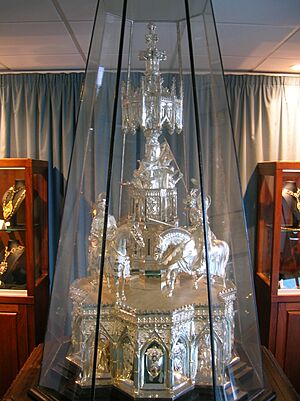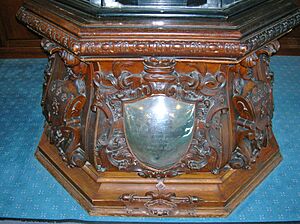Eglinton Trophy facts for kids
The Eglinton Trophy is a huge, fancy silver decoration. It was given to the 13th Earl of Eglinton by his friends and fans. This special gift celebrates a medieval event called the Eglinton Tournament. This tournament happened at Eglinton Castle in Kilwinning, Scotland, in 1839.
The trophy is very tall, about 4 feet 8 inches (140 cm). It weighs a lot too, about 1600 ounces (45 kg). This makes it one of the biggest and most amazing trophies ever made!
Contents
History of the Eglinton Trophy
How the Trophy Was Funded
A group of people, led by the Marquess of Londonderry, decided to raise money for a special gift. They wanted to give the Earl of Eglinton a silver trophy. This was to remember the Eglinton Tournament, which brought back the old days of knights and chivalry.
About 239 people gave money to create the trophy. Each person could give only a certain amount, up to twenty guineas. This would be about £900 in today's money.
Designing and Making the Trophy
The Eglinton Trophy is 4 feet 8 inches (140 cm) tall and weighs 1600 ounces (45 kg). It was designed by Edmund Cotterill, a famous artist. The company Messrs. R & S Garrard, who were silversmiths in London, made it.
Making the trophy cost £1,775 back then, which is like £78,277 today. It took four years to finish this amazing piece! Edmund Cotterill was known for his beautiful designs for silver items. The trophy is made from many silver pieces that were shaped and then put together.
The Eglinton Trophy is made of real Sterling silver, not just silver-plated metal. It has a wide base that looks like a castle wall. On the sides of the base are shields with the family symbols (coats of arms) of the fourteen knights who took part in the tournament.
The trophy looks like a fancy Gothic pulpit. Under a tall, pointed arch, there is a figure of Jane Georgiana, Lady Seymour. She was the Queen of Beauty at the tournament. She is shown placing a wreath on the head of the Earl of Eglinton, who won the tournament.
Next to the Earl, you can see other figures. These include the Knight Marshal, a squire, and a guard. There are also two hunting dogs, two young pages, and a lady in waiting. It looks like the squire and the lady in waiting are looking at each other!
The trophy is kept safe inside a glass case. This case has wooden frames and sits on a fancy eight-sided wooden base. This base has four coats of arms and silver decorations. A silver plaque on the base says: "Presented to Archibald, Earl of Eglinton, by the Visitors to the Eglinton Tournament held at Eglinton Castle. MDCCCXXXIX."
What the Hallmarks Mean
A Hallmark is a special stamp on silver that tells you important things about it. The Eglinton Trophy has a hallmark on its base.
- The Silver Standard Mark is a lion walking. This means the silver is 92.5% pure, which is called Sterling silver.
- The City Mark is a leopard without a crown. This shows it was made in London after 1822.
- The Maker's Mark is "RG" under a crown. This means it was made by R & S Garrard after 1835. The crown means they became official Crown Jewellers for Queen Victoria in 1843.
- The Date Letter is a Gothic "G". This tells us it was officially checked in 1842.
- The Duty Mark is Queen Victoria's head. This means a tax was paid on the item, and it was made before 1890.
Even though the trophy was checked in 1842, it was fully put together and given to the Earl in 1843.
Where the Trophy Has Been Kept
The Eglinton Trophy was given to the Archibald Montgomerie, 13th Earl of Eglinton in 1843. It was first kept in the library at Eglinton Castle. Later, it moved to the Ayr County Hall. The trophy was even shown in a famous newspaper called The Illustrated London News in June 1843.
Today, the trophy is still in its original glass and wood case. It is kept at Cunninghame House, which is the main office for North Ayrshire Council. The 14th Earl of Eglinton loaned it to the people of Ayrshire, but it still belongs to the current Earl.
For a short time, while the council's headquarters were being built, the trophy was kept at Wellwood. This is the home of the Irvine Burns Club and a museum.
In 1989, the trophy was moved to the Eglinton Country Park visitor centre. This was for a special event that marked 150 years since the original tournament. It was also loaned to the famous Victoria and Albert Museum in London.
The trophy is very important to the history of the area. It is insured for a very large amount of money. In 2011, it was loaned to East Ayrshire Council for an exhibition in Kilmarnock. You can usually see the trophy by arranging a visit beforehand.
Other Trophies from the Eglinton Tournament
The Earl of Eglinton received another silver trophy from 300 people in Glasgow. In 2014, a silver statue of a knight on a horse was bought by the East Ayrshire Council. This statue is about 44 cm tall.
People believe this knight statue is the only part left of that "second silver trophy." The rest of it might have been melted down for its silver in the 1920s. The hallmark on the statue shows it was made in 1840, three years before the main Eglinton Trophy was finished. It was made by Benjamin Smith III of London and D.C.Rait of Glasgow.








